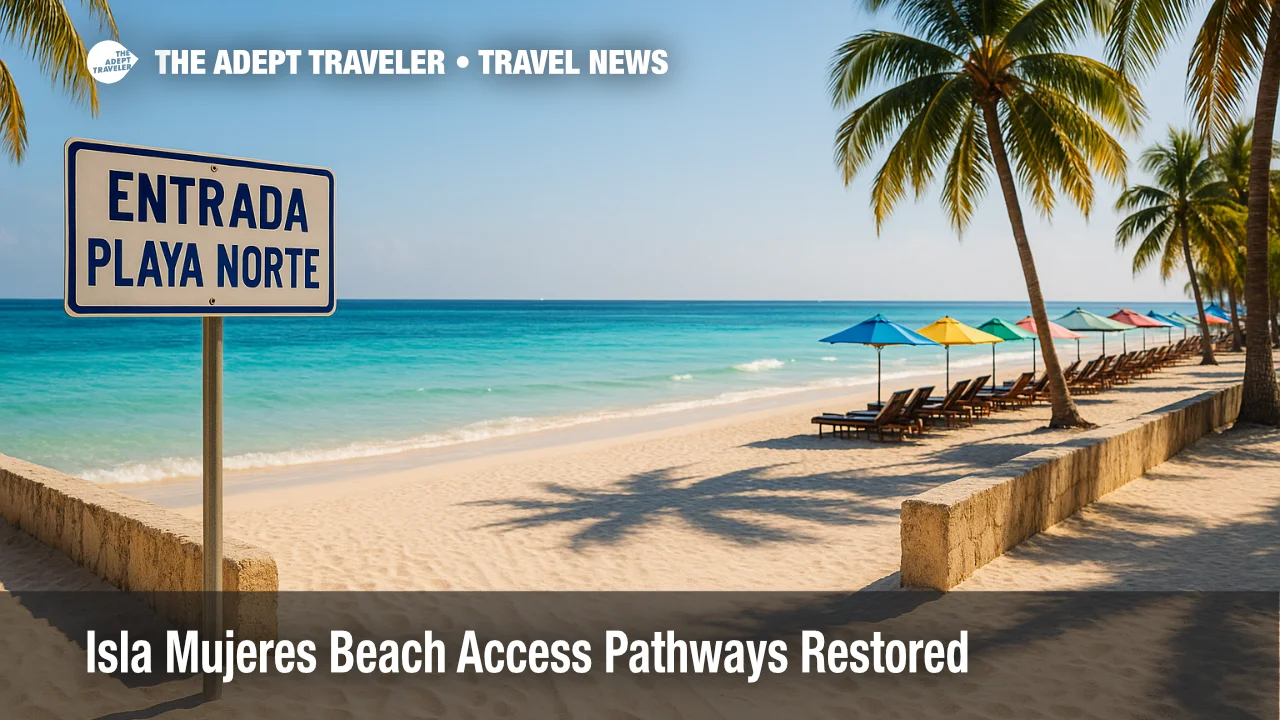Isla Mujeres beach access pathways restored

Officials on Isla Mujeres, near Cancún, have launched a program to reopen public pathways to the sea and keep shorelines walkable. The first phase cleared two bocacalles, the street-end passages that connect neighborhoods to the beach, and set a five-meter, waves-edge buffer for free movement along the water. The city also plans tighter oversight of lounge chairs and daybeds to ensure concessionaires respect their permitted footprints. Work began last week at Playa Norte, one of the island's busiest stretches. Local leaders say the goal is to return straightforward access to residents while keeping the destination orderly for visitors.
Key Points
- Why it matters: Restored entries and a five-meter shoreline walkway protect public beach access.
- Travel impact: Two Playa Norte entrances reopened at Hidalgo Street and Carlos Lazo Street.
- What's next: Ongoing inspections will police vendor footprints and keep the five-meter path clear.
Snapshot
The access push starts at Playa Norte, where the city reopened two public beach entries and committed to a continuous five-meter zone for pedestrians near the waterline. Enforcement teams will check that lounge setups and beach furniture stay inside permitted areas. Isla Mujeres sits a short ferry ride from Cancún, which is the nearest major gateway. Most travelers arrive via Cancún International Airport (CUN), with nonstop flights from Miami typically around two hours. The measures come during the peak summer period, when crowds and vendor sprawl can choke walkways if not managed.
Background
Mexico reaffirmed free public access to all beaches in 2020, adding fines for anyone who blocks entry. The law requires that the public can reach and transit beaches, even where private lots front the coast. Isla Mujeres' program fits that framework while addressing a local concern, the bottleneck at street-end paths and along the surf line at crowded shores. Separate from national law, Quintana Roo municipalities manage enforcement on the ground through Zofemat, the Federal Maritime-Terrestrial Zone authority. The island's effort pairs clearance of bocacalles with day-to-day vendor oversight so that public walkways remain usable during busy hours.
Latest Developments for Isla Mujeres beach access
Playa Norte entries reopen at two street ends
Crews cleared two public beach entrances at the end of Hidalgo Street and at the end of Carlos Lazo Street, restoring direct neighborhood-to-shore connections. The work is part of a wider plan led by Mayor Atenea Gómez Ricalde, with coordination across Urban Development, Environment and Ecology, Cadastre, Inspection, and Zofemat. Officials say more locations will follow once inspections and mapping confirm historical routes. For visitors, the change reduces backtracking through hotel zones to reach open shoreline. For residents, it restores traditional paths used for errands and family outings. See the Riviera Maya News report for details: riviera-maya-news.com/isla-mujeres-starts-projects-to-restore-beach-access-and-ensure-free-passage/2025.html.
Five meter surf line walkway and vendor boundaries
The city is also enforcing a five-meter clearance from the point where waves break so families and visitors can walk the shore without weaving through lounge setups. Planning Director Soledad Che Celis said concessionaires must keep daybeds and chairs inside their permitted footprints. Local outlets report that this rule accompanies renewed audits of beach furniture density during high-traffic hours. For travelers, the result should be clearer promenades at popular sections of Playa Norte.
Analysis
Public shoreline access is a recurring flashpoint in the Riviera Maya, where rapid growth often outpaces on-the-ground management. Isla Mujeres is using two levers that matter to travelers: keeping street-end gateways open and preventing furniture creep that narrows the wet-sand corridor. The approach aligns with Mexico's guarantee of free access while focusing on practical fixes where congestion is worst. Success will depend on steady field inspections, clear signage at reclaimed entries, and quick responses when vendors exceed their allotments. Zofemat's role is central because the federal maritime-terrestrial zone, generally 20 meters above the high-tide mark, is where many commercial setups sit, and where concessions can be sanctioned if they overreach. If enforcement holds through the autumn travel surge, Isla Mujeres could become a model for other Riviera Maya communities facing similar pressures.
Final Thoughts
Reopening bocacalles at Playa Norte and protecting a five-meter surf-line walkway are modest steps with outsized value. They reconnect neighborhoods to the coast, reduce friction for visitors, and show how local rules can complement national guarantees on beach access. Continued enforcement will be key as crowds return for fall and winter holidays. For a smoother day at the beach, arrive early, use signed public entries, and respect marked buffer zones. If authorities keep pace with inspections, the island should see lasting gains in comfort and circulation along the shore, reinforcing the appeal of Isla Mujeres beach access.
Sources
- Isla Mujeres starts projects to restore beach access and ensure free passage, Riviera Maya News
- Isla Mujeres recupera accesos al mar y regula espacio en playas, Quintana Roo Hoy
- Mexico enacts law to guarantee public access to all beaches, AP News
- Direct flights MIA to CUN and typical duration, FlightsFrom
- The Mexican Maritime Zone Explained, MLSVallarta
